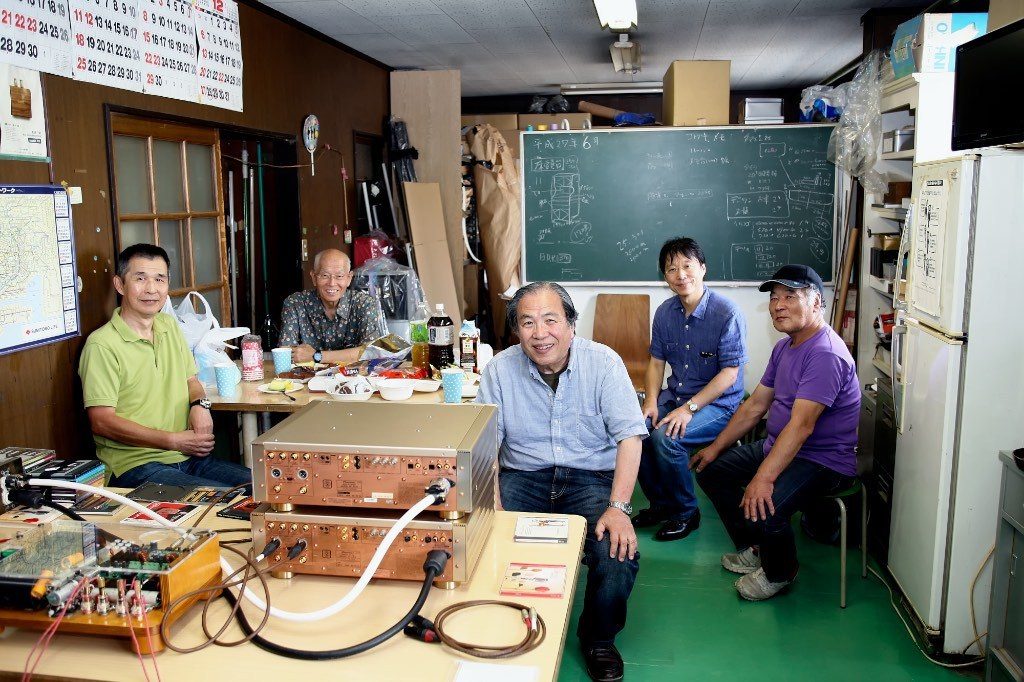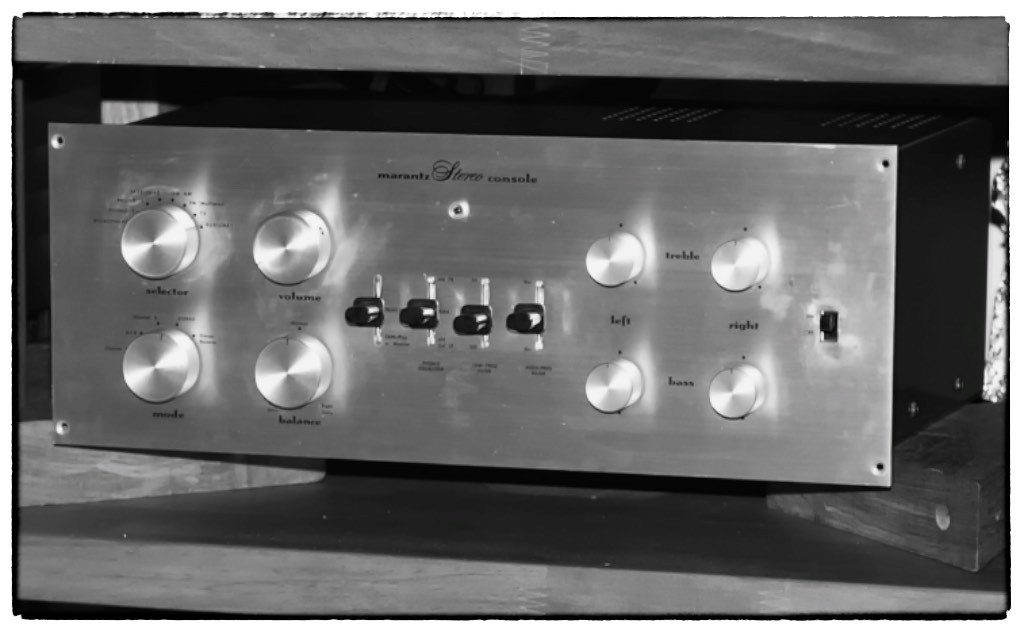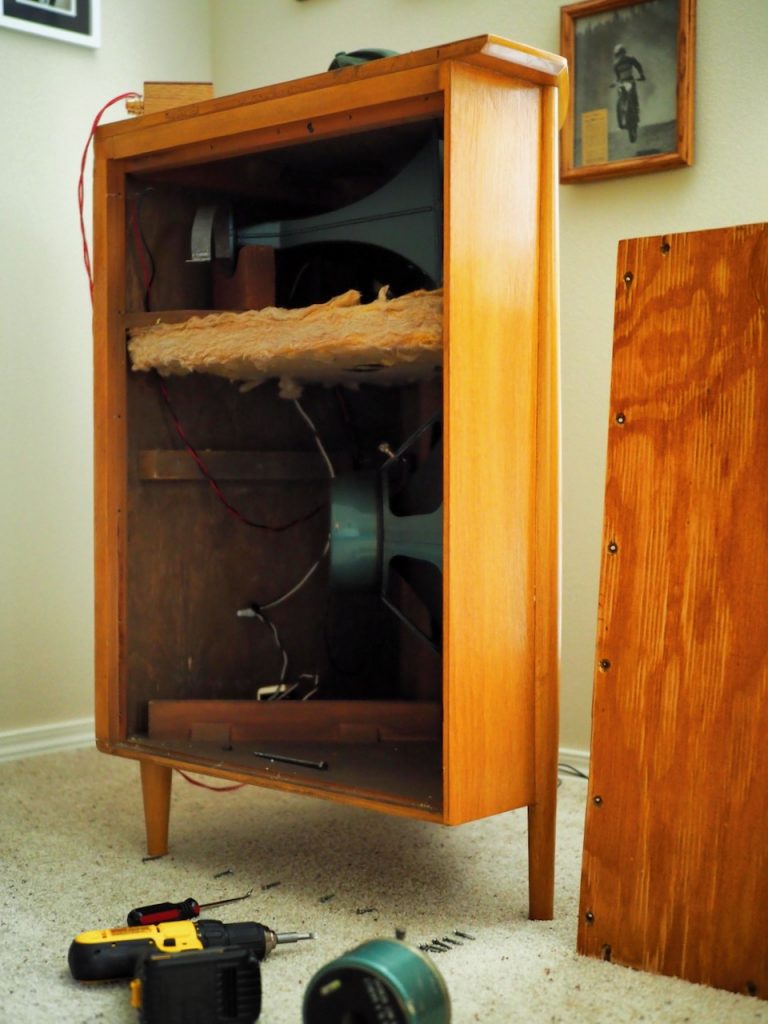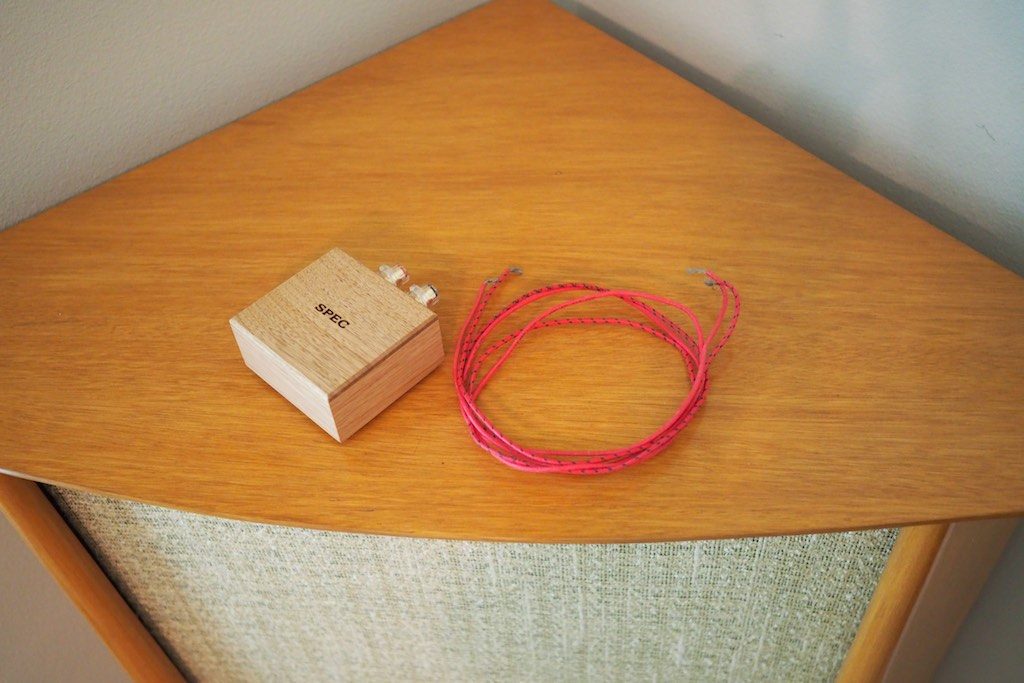It is always a pleasure to hear from our good friend Mr. Shirokazu Yazaki. Today Yazaki-san is sharing Part 10 of My Adventure With My Old Marantz Model 7, his ongoing series of articles with us, and telling us about the discoveries he's made during his audio adventures since we last heard from him, and more!
Please note that this is a multi-page article - eight pages - and when you get to the bottom of each page, click on the link to the next page, and it will take you to the next page in the article.

Yazaki-san (center) with friends in Tokyo.
If you are just getting started reading Yazaki-san's articles, I think you'll find them to be full of fascinating insights on how to achieve "real sound", not only with the vintage Marantz Model 7 preamplifier, but with insights that are broadly applicable to your own audio systems as you pursue "real sound" for yourself.
Here is an index to Yazaki-san's previous articles about his vintage Marantz Model 7 preamplifier adventures:
- My Adventure with My Old Marantz Model 7, Part 1 (HERE)
- My Adventure with My Old Marantz Model 7, Part 2 (HERE)
- My Adventure with My Old Marantz Model 7, Part 3 (HERE)
- My Adventure with My Old Marantz Model 7, Part 4 (HERE)
- My Adventure with My Old Marantz Model 7, Part 5 (HERE)
- My Adventure with My Old Marantz Model 7, Part 6 (HERE)
- My Adventure with My Old Marantz Model 7, Part 7 (HERE)
- My Adventure with My Old Marantz Model 7, Part 8 (HERE)
- My Adventure with My Old Marantz Model 7, Part 9 (HERE)
Dear Yazaki-san,
Here's a big "Thank you!" for sharing your discoveries and wisdom with us here at Jeff's Place.
Myself, and all those who come to Jeff's Place to read your articles, truly appreciate you taking the time to write them for us - thank you so much!
All the best,
Jeff
Additions Since the Original Publication Date:
- Please see the two new slides for "The Latest Modification of My Model 7K - Just the Goal of My 'Resistor Adventure'" with expanded information about the NOS IRC metal-film resistors on page 6.
- Please see the new slide about "Ryszard-san's Model 7 After the Modification" on page 7.
- Please see the new slide about "Roy-san's Model 7 After 2nd Modification by Jun Honda-san" on page 7.
- Please see all of the new summary slides from Yazaki-san co-located on page 8 following his epilogue that show the latest status for modifications to his Marantz Model 7 K from his 'Resistor Adventure' and 'Capacitor Adventure'.
If there are more updates / further thoughts from Yazaki-san in the future I will notify you of their location here.
Thank you to Yazaki-san for the additional information in the latest slides!
My Adventure with My Old Marantz Model 7, Part 10: The 2nd Modification of Alan-san's & Roy-san’s Model 7
By Shirokazu Yazaki

Yazaki-san's vintage Marantz 7k preamplifier.
Please allow me to start this Part 10 with a very personal conversation with my most trusted “Kindred Spirit”, Alan-san. He is surely an enthusiast who has long looked for “Real-Sound”, and now with this 2nd Modification of his Model 7, he just truly feel he might have reached at some goal.
Alan-san's beloved "Sasha & Obie" and my dog "Nico"
So I’d like to share with you the story of his recent adventure here. Well, when we, Alan-san and I talked about the coming 2nd modification of his Model 7, just on 3rd last October, I got the mail and received his sorrow-filled words, “We have had a little sad news, two of our cats passed from age related health complications.
Our indoor Grande dame Sasha, finally lost her battle with renal failure. She was 19 years old and full of love and a really great companion for us and the other cats. She was an available surrogate mom when new kittens showed up and the “alpha cat.”

Obie was an outdoor feral cat that showed up in our backyard over ten years ago. He was our constant outdoor companion and a really friendly kind old soul. He absolutely refused to be placed in a pet carrier, so no trips to the Vet for him. He was clever and able to avoid the coyotes and found a way to adapt to the armadillos, raccoons and skunks that would come through nightly. Here is a picture from earlier this year, he is orange short-hair cat on the right side and the fellow on his back is Rufus...Rufus had been hanging outside with Obie for the last two years...good buddies, kindred spirits.”
In these Alan-san’s humble words, “a little sad news “and more likely the requiem to his beloved cats, in other words the true sadness and the grief of his pet loss, followed Sasha and Obie was painfully conveyed to me.
Why I deeply emphasized with his grief as my own pain, would be probably because I have lived with my dog, Nico-chan for this 8 years since we, my wife and I received her from the shelter. She is blessed with “White-Cross” on her breast and friendly nature, furthermore good health. And now, she is not only a pet for us but also a precious member of my family.
Truly, the dog walking with her every day has kept also my health and so I have owed so much to her. That’s why I can feel painfully the sadness of Alan-san, had been living with Sasha of the fascinating blue eyes for 19 years long.
Well, but it’s only a part of the close and vast amount of conversations with Alan-san in this 5 or 6 years from when we first met just a few days before Rocky Mountain Audio Fest 2015. Alan-san had already known me at that time because he has been an eager reader of Jeff’s Place and I had sent him a spool of NOS WE16GA cable, corresponding to his request before we met at Denver.
And then, as I realized Alan-san’s taste were no different from my own “Real-Sound”, I had been looking for, and I wanted to live up to his trust in me. So I decided to commit myself as not only a good “Kindred Spirit” but also his very personal adviser. Well, as I can say now, thankfully, I believe he has been a true understanding for my idea of “Real-Sound” and also my true patron in a good sense throughout more than last 5 years.
The Altec Corona: My Consideration and Experiences about Speakers
I'm sorry that this chapter has become very long, but here I would like to look back on the “Real-Sound” adventure” between Alan and me over the last five or six years as a prelude to the 2nd modification of Model 7, the main subject.
Certainly, the content of this chapter extends to audio technology in general, or my thoughts on it, but has very personal memorable implications for me. Therefore, readers are welcome to skip this chapter and continue reading the final chapter about my latest “Resistor Adventure”, which is the subject of this Part 10.
At that time, Alan-san had enjoyed relatively updated high-end and large-scale 4 way speaker system with usual low-efficiency. But I suppose, he was not able to feel the full joy and trust in the sound produced by this latest speaker.
In his long quest for audio, he might have aspired to the sound of vintage high-efficiency speakers, as it was something that he wanted to hear.
Once in the end of 2015, or early 2016, he told me that he went all the way to visit the owner of a truly vintage speaker system with Paula-san. The speaker he wanted to actually experience, which was the purpose of their long trip, was the “Siemens Eurodyn”, whose unit was embedded in a huge flat baffle that mostly covered the walls.
However, of course, Paula-san refused to put this huge flat baffle in their living room, I heard. It would be true that the flat baffle type is particularly attractive for its open sound especially in the low range, but the appearance of the speakers or the design might be also an extremely important factor in enjoying music comfortably for even audio enthusiasts. I also speculated that the too old-fashioned sound might have been rejected by Alan-san, who has long tasted and been used to the latest modern audio sounds.
To tell the truth, I was already asked to build up a pair of PX25A (DA30) mono SETs for Alan-san, so it might have been a tacit understanding with each other, but I felt that searching or selecting a speaker suitable for this tube amplifier might be my responsibility.
Just on 28th June 2016, I sent the e-mail below to Alan-san:
“Well, I suppose, you have been searching for high efficiency speaker, matches well with your coming WE310A-PX25A mono SET. Well, I have long loved Altec 414A woofer's sound for more than 40 years because that the most important part of the sound, mid-to-low range is so natural and real compared to any other speakers I have experienced. Of course, I wanted to have the Altec 416A, 15 inch woofer, but the size of speaker box was too big to arrange into my room."
"Koizumi-san, the craftsman of Onken compression drivers and horns, I have respected, and once said that 416A would be the best and supreme woofer in all ages and countries and also added that 515 woofer's magnetic circuitry might be too powerful that it leads the sound to the state of over-damping for home use."
"So if you have not yet found a high-efficiency speaker, I would like to suggest you to get the speaker, using the Altec A7's units. I just come across such a speaker, a pair of Altec 832A Corona in mint condition on our Yahoo Japan Auction site below.
Note from Jeff: Here is a photo of the vintage Altec 832A Corona loudspeakers that I bought from LA Jazz Audio (Photo by LA Jazz Audio). I thought seeing this photo of the Altec 832A Corona loudspeakers would provide additional context for you regarding Yazaki-san's discussion of them.

Fortunately, LA Jazz Audio is located in Los Angeles, USA, and you could easily contact him. Furthermore, LA Jazz Audio has a lot of vintage Altec speakers, and not only Coronas.
When I first found this Corona, I thought it was be the best designed, not only the appearance, but also for the technical matter of being best for the original A7 drivers. The Corona is raised off of the floor, is free from standing waves, and the design of the inner cabinet and the box is made of fabulous laminated wood by real "Douglas fir".
Note from Jeff: I thought it might be helpful for you to see the inside of my vintage Altec 832A Corona loudspeakers for additional context for Yazaki-san's discussion. Components are the 16 Ohms 803A bass drivers (1947-1958), 16 Ohms 802D compression drivers (1957-1972), 811B HF horns, and N800E crossovers.

Also, the impedance of the drivers, 16 ohms would bring out more sensitive sound compared to latter-day 8 ohm because of the lighter weight of its voice coil.
Note from Jeff: I thought it might provide helpful context to show how the vintage Altec Corona 832A loudspeakers are intended to be positioned in a room corner.

Above all, what a beautiful the appearance is!”
What surprised me very much was the reply mail from Alan-san, which arrived on the next day, 29th. He already picked out just the same speaker on eBay USA, and bought it from LA Jazz Audio!
Well, I couldn’t believe that he decided to have it and already made a successful bid in such a short time. I was so much surprised at Alan-san's quick decision and also the action because I had received a picture of the sea dyed in a beautiful sunset from him and knew that the couple were on vacation just during this period.
In this way, Alan-san luckily started to look for “Real-Sound” audio with these rare vintage Altec Corona 832A loudspeakers in almost mint condition.
Well, I’d like to transfer his joyful impressions at that moment here. On 19th August, Alan-san told me that:
“Paula really loves the sound and the appearance of the Altec Corona speakers. She immediately said, "They sound so alive and real, I like them!" So, it appears that she is a "fan" and a much talented listener, ha-ha!”
Note from Jeff: I thought it might be helpful to show a closeup of the Spec RSP-AZ9EX Real Sound Processor - impedance compensator - that Yazaki-san sent me on top of my vintage Altec 832A Corona loudspeaker for additional context.

On 22nd, he described the sound of his Corona with the custom “Impedance Compensator”, I assembled it for him in advance as follows:
“I had a great listening weekend here with Japanese Green Tea and the fantastic “Impedance Compensator” for my Corona, what a wonderful piece of kit! When placed in the system, I found that there was introduced sense of continuity and richness within the flow of the music. The performers became much more engaging and there was a feeling of immediacy and of the moment being "alive." Before adding them to the mix, there was a realness and live-event sense that I felt was due to the Altec speaker's hi-efficiency capabilities along with the immediacy and quickness of the drivers."
"However, with the "Impedance Compensator" the music felt more organic, palpitating, and "Real" as if it was alive breathing there and flowing out of the speaker cabinet ... sort of like a fundamental difference that you may find with old-growth Brazilian Rosewood in a vintage guitar. Really, really sweet, Yazaki-san, thank you very much for this wonderful gift!"
"The cats, well, they spent the day in the bedroom locked away from any temptation to create mischief! Have a great week, Paula-san says, "Hello," to you both!!”
Of course, I was so delighted to hear it, but according to the results or his impressions, it would be definitely clear that for reproducing more musical and real sound, Alan-san had made a wise and great decision of replacing the modern designed high-end 4 way speaker to this vintage 2 way horn speaker system with the higher sensibility, close up to 100 dB/w/m.
I will refrain from mentioning the differences of each speaker’s design here, but I would like to give some consideration to the amplifiers that drive these speakers.
In Japan, this kind of thing has been often said for a long time that highly efficient vintage speakers or such a driver, consisting of very powerful magnetic circuit and an extremely lightweight diaphragm, cannot be driven by usual and high power semiconductor amplifiers, even if it is proud of a significantly high power, as the chemistry between them is extremely bad. I think this can be a clear qualitative explanation. And here, I would like to restate the description in Part 3 (HERE).
"Needless to say, the speaker is the transducer which converts some electric energy. And also you should be reminded of one more thing, “Counter electromotive Force” of speaker. The motion of speaker is started in the magnetic circuit or voice coil of the unit or driver by the current flowing from the amplifier according to “Fleming's Left-Hand Rule”, but at the same time this motion raises up the counter electromotive force in the voice coil by “Fleming's Right-Hand Rule”."
"It is true that amplifier drives the speaker, but it is also true that the speaker affects the amplifier by this “Counter Electromotive Force”, and this force is proportional to the motion speed of the voice coil or the diaphragm."
"Given that, it is clear that a high-efficiency or highly-sensitive driver with a strong magnetic circuit and a lightweight diaphragm will generate this force more strongly than a low efficiency speaker."
"Well, it surely becomes a tough disturbance factor to the amplifier because of its negative feedback circuit. In any case, this disturbance returns to the front stage part of the amplifier by the NFB circuit, and the phase turns particularly complicated in the amplification stage, and the signal itself is modulated."
"Especially ironically, in usual semiconductor amplifiers, it can be said that this influence is enormous due to the strong NFB circuit."
"Anyways, the "Impedance Compensator", which could parry easily or absorb the “counter electromotive force”, might surely have worked well in Alan-san’s Corona loudspeakers."
"I should explain one more fact, that the amplifier that Alan-san had used at that time was the SPEC F33REX with the latest Class D operation, in principle which resisted well the negative effects of back electromotive force, generated from the powerful magnetic circuitry of the driver units of Altec Corona 832A."
Well, although it may be slightly out of the subject, but I would like to take this opportunity to write down the sound quality merit of the plywood by “Douglas fir”, adopted for the speaker box of Alan-san’s Altec Corona.
Of course, this material seems to have been the preferred choice for these early various vintage Altec speaker boxes.
Note from Jeff: The Coronas (and Lagunas) had cabinets that were custom made for Altec by Glenn of California, which was a craft furniture maker producing furniture in the California Modernist style that was popular in the 1940s-1950s, and the cabinets were one of the Coronas selling points. Customers could order Coronas or Lagunas and they were styled to complement the Glenn of California furniture they had in their home, and as such were intended to "disappear" into the corners as functional furniture so they weren't too room dominating. They were considered to be high-performance "art speakers" for a well decorated Glenn of California furnished home.
By the way, it may be better to mention my relationship with the woodworking materials here. In fact, what is an extremely unique in my Pioneer career is that I was in charge of the rebuilding a large-scale woodworking production company in Semarang, Indonesia just 20 years ago.
This production company mass-produced more than 1 million sets of low-cost audio system speakers in one year not only for Pioneer, the parental company but also for Sony, annually, but the profitability of this business was extremely poor, and a drastic improvement in profit and loss was urgently needed.
It was up to me to find a new business direction. Fortunately or luckily enough, we were able to undertake woodworking-related work from the world-renowned musical instrument company in Japan, Yamaha and Roland.
Among them, although I myself was in charge of managing this production company, but also I had been very busy with sales technology and the quality control department as my territory. Now, I'm very grateful for it, for I had to become familiar with the materials such as particle board and MDF (Medium Density Fiber Board) through that work.
Since Semarang was a shipping port for teak flooring and furniture with unique wood carvings, I became interested in the golden, glossy and beautiful real-wood teak itself. In addition, I personally became acquainted with the skillful engineers of these musical instrument makers, and I was given the opportunity to learn about the relationship with the sound quality and those materials from them.
What I still remember clearly is the words in a conversation with an experienced mechanical designer from Roland. He said, "I prefer to use particle board instead of MDF for the speaker box built into the electronic piano, because the material MDF only absorbs the sound of a speaker unit or driver."
The expression of "absorbing the sound" means something like this. In other words, the sounding of MDF speaker box is only poor, and it is not possible to obtain rich tones and sounds that are typical of a piano. Simply put, the differences is that particle board is made of a small piece of wood that retains the original characteristic of the wood that has been crushed into small pieces, and MDF is made of the material that has been further processed into fibers. Then, each of them is heated and pressure-molded into a plate shape with an adhesive.
Also, if you look at the cut surface of the particle board, you can see that there are a lot of gaps between the pieces of wood, but in MDF you can see that the adhesive covers the fibers firmly. Although it is a wood material, the high vibration absorption or damping of MDF is probably due to the physical characteristics of this adhesive.
In recent years, high-end speakers often use MDF, which facilitates smooth surface processing and can also process design-oriented curved surfaces. There is also a design concept that for their image of high fidelity reproduction, only the diaphragm of the speaker driver should sound, and no useless sound should be emitted from the speaker box.





























